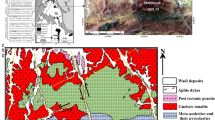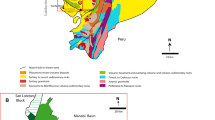Abstract
As a part of the Kermanshah ophiolite in western Iran, the Cretaceous Nourabad-Dinavar ophiolitic complex is a remnant of the Neo-Tethys oceanic lithosphere and represents transitional mantle-crust and upper crust units in the Nourabad and Dinavar regions, respectively. All the units were affected by the two metamorphic regimes of static metamorphism and dynamic metamorphism. The whole-rock chemical data of the basic samples (i.e. gabbros, basalts, and dykes) show that they are related to the island-arc regime. The main reasons for this conclusion are as follows: their affinity with the calc-alkaline series, LREE enrichment, and subduction-related proxies such as the negative anomalies of Nb, Ta, Zr, and Hf and the positive anomaly of Th. On the other hand, the mineral chemistry analysis confirms that the studied ophiolitic complex is a MORB-type ophiolite emplaced in the supra-subduction zone. This is supported by mineralogical evidence including the compositional dependence of olivines (fo90-91) on the spinel peridotite mantle facies, spinel minerals (Al-chromite and Mg/Cr-bearing hercynite), and Mg-rich orthopyroxenes (enstatite) in the harzburgites. The geochemical modeling implies that this complex evolved through the following successive magmatic steps: 1) the partial melting of a mixed NMORB-EMORB (50:50) source producing spinel harzburgite residues; 2) the fractional crystallization of the basic partial melts during their ascent to the surface and the formation of gabbro bodies; 3) the assimilation and fractional crystallization process as the NMORB components re-enter the chamber and produce basic pillow lavas, lava flows, and some fine-grained gabbro bodies (i.e. dykes). Accordingly, it can be interpreted that the emplacement history of the studied ophiolite succession has two stages: 1) an obduction stage in the Campanian; 2) an exhumation stage in the post-Cretaceous.









Similar content being viewed by others
Availability of data and materials
All data presented in the text of the article are fully available without restriction from authors upon request. Code availability is not applicable.
References
Agard P, Omrani J, Jolivet L, Mouthereau F (2005) Convergence history across Zagros (Iran): constraints from collisional and earlier deformation. Int J Earth Sci 94:401–419
Allahyari K, Saccani E, Pourmoafi M, Beccaluva L, Masoudi F (2010) Petrology of mantle peridotites and intrusive mafic rocks from the Kermanshah ophiolitic complex (Zagros belt, Iran): implications for the geodynamic evolution of the Neo-Tethyan oceanic branch between Arabia and Iran. Ofioliti 35:71–90
Ancey M, Bastenaire F, Tixier R (1977) Statistical control and optimization of X-ray intensity measurements. J Phys D: Appl Phys 10:817–830
Ancey M, Bastenaire F, Tixier R (1980) Application of statistical methods to electron probe microanalysis. In: Beaman DR, Ogilvie RE, Wittry DB (eds) Proceedings of the 8th International Congress on X-Ray optics and Microanalysis, Boston/MA 1977. Pendell Publishing Company, Midland/MI, p 49
Ao S, Xiao W, Khalatbari-Jafari M, Talebian M, Chen L, Wan B, Weiqiang J, Zhang Z (2016) U-Pb zircon ages, field geology and geochemistry of the Kermanshah ophiolite (Iran): from continental rifting at 79 Ma to oceanic core complex at ca. 36 Ma in the southern Neo-Tethys. Gondwana Res 31:305–318
Arai S (1994) Characterization of spinel peridotites by olivine–spinel compositional relationships: review and interpretation. Chem Geol 113:191–204
Bosi F, Biagioni C, Pasero M (2019) Nomenclature and classification of the spinel supergroup. Eur J Mineral 31:183–192
Braud J (1978) Geology Map of Kermanshah, Scale 1:250000. No. C6. Geology Survey of Iran, Tehran
Cas RAF, Wright JV (1988) Volcanic successions: modern and ancient. Unwin Hyman, p 528
Condie KC (1989) Geochemical changes in basalts and andesites across the Archean-Proterozoic boundary: identification and significance. Lithos 23:1–18
De Hoog JCM, Gall L, Cornell DH (2010) Trace-element geochemistry of mantle olivine and application to mantle petrogenesis and geothermobarometry. Chem Geol 270:196–215
Deer WA, Howie RA, Zussman J (1997) Rock forming minerals: Orthosilicates, 2nd edn. Geological Society of London, p 932
Deer WA, Howie RA, Zussman J (2013) An introduction to the rock forming minerals 3rd excerpted student edition. Geological Society of London, UK, pp 485–489
Delaloye M, Desmons J (1980) Ophiolites and mélange terranes in Iran: a geochronological study and its paleotectonic implications. Tectonophysics 68:83–111
Desmons J, Beccaluva L (1983) Mid-oceanic ridge and island arc affinities in ophiolites from Iran: paleogeographic implication. Chem Geol 39:39–63
Dick HJ, Bullen T (1984) Chromian spinel as a petrogenetic indicator in abyssal and alpine type peridotites and spatially associated lavas. Contrib Mineral Petrol 86:54–76
Droop GTR (1987) A general equation for estimating Fe3+ concentrations in ferromagnesian silicates and oxides from microprobe analyses, using stoichiometric criteria. Mineral Mag 51:431–435
Fleet ME, Barnett RL (1978) ivAl/viAl partitioning in calciferous amphiboles from the Frood Mine Sudbury, Ontario. Can Mineral 16:527–532
Frisch W, Meschede M, Blakey R (2011) Plate tectonics: continental drift and mountain building. Springer-Verlag, Berlin Heidelberg
Gargiulo MF, Bjerg EA, Mogessie A (2013) Spinel group minerals in metamorphosed ultramafic rocks from Río de Las Tunas belt, Central Andes, Argentina. Geol Acta 11:133–148
Ghazi AM, Hassanipak AA (1999) Geochemistry of subalkaline and alkaline extrusive from of the Kermanshah ophiolite, Zagros Suture Zone, Western Iran: implications for Tethyan plate tectonics. J Asian Earth Sci 17:319–332
Hastie AR, Kerr AC, Pearce JA, Mitchell SF (2007) Classification of altered volcanic island arc rocks using immobile trace elements: development of the Th-Co discrimination diagram. J Petrol 48:2341–2357
Hawthorne FC, Oberti R, Harlow GE, Maresch WV, Martin RF, Schumacher JC, Welch MD (2012) IMA Report – Nomenclature of the amphibole supergroup. Am Min 97:2031–2048
Hout F, Hébert R, Varfalvy V, Beaudoin G, Wang CS, Liu ZF, Cotten J, Dostal J (2002) The Beimarang Melange (Southern Tibet) brings additional constraints in assessing the origin, metamorphic evolution and obduction processes of the Yarlung Zangbo Ophiolite. J Asian Earth Sci 21:307–322
Humphries DW (1992) The preparation of thin sections of rocks, minerals and ceramics, vol 24. Roy Micr Soc, Oxford Science Publications, Microscopy Handbooks
Le Maitre RW, Streckeisen A, Zanettin B, Le Bas MJ, Bonin B, Bateman P, Bellieni G, Dudek A, Efremova S, Keller J, Lameyre J, Sabine PA, Schmid R, Sørensen H, Woolley AR (2002) Igneous rocks, a classification and glossary of terms. Recommendations of the International Union of Geological Sciences, Subcommission on the Systematics of Igneous Rocks. Cambridge University Press, Cambridge/UK
Meschede M (1986) A method of discriminating between different types of mid-ocean ridge basalts and continental tholeiites with the Nb-Zr-Y diagram. Chem Geol 56:207–218
Morimoto N, Fabriès J, Ferguson AK, Ginzburg IV, Ross M, Seifert FA, Zussman J, Aoki K, Gottardi G (1988) Nomenclature of pyroxenes. Mineral Mag 52:535–550
Pagé P, Bédard JH, Schroëtter JM, Tremblay A (2008) Mantle petrology and mineralogy of the Thetford Mines Ophiolite Complex. Lithos 100:255–292
Pearce JA (1982) Trace element characteristics of lavas from destructive plate boundaries. In: Thorpe RS (eds) Andesites: Orogenic Andesites and Related Rocks. John Wiley and Sons, New York 525–548
Pearce JA, Robinson PT (2010) The Troodos ophiolitic complex probably formed in a subduction initiation, slab edge setting. Gondwana Res 18:60–81
Pearce JA, Barker PF, Edwards SJ, Parkinson IJ, Leat PT (2000) Geochemistry and tectonic significance of peridotites from the South Sandwich arc–basin system, South Atlantic. Contrib to Mineral Petrol 139:36–53
Pouchou JL, Pichoir F (1991) Quantitative analysis of homogeneous and stratified microvolumes applying the model “PAP.” In: Heinrich KFJ, Newbury DE (eds) Electron probe quantitation. Plenum Press, New York/NY, pp 31–75
Rahimzadeh B, Veisinia A, Masoodi F, Tabbakh Shabani A (2019) Petrogenesis and tectonics of Niabad-Qaleje ophiolitic complex, part of Sarvabad complex: using the Cr-spinel mineral chemistry. Kharazmi J Earth Sci 5:55–78 (in Farsi with English Abstract)
Ribbe PH (1983) Chemistry, structure and nomenclature of feldspars. In: Ribbe PH (ed) Feldspar mineralogy, vol 2, 2nd edn. Rev Mineral, pp 1–19
Ricou LE (1971) Le métamorphisme au contact des péridotites de Neyriz (Zagros interne, Iran): développement de skarns à pyroxène. Bull Soc Géol France 7(1–2):146–155
Ricou LE, Braud J, Brunn JH (1977) Le Zagros. Mémoire Hors Série Société Géologique France 8:33–52
Ring U, Brandon MT, Willett SD, Lister GS (1999) Exhumation processes. In: Ring U, Brandon MT, Willett SD (eds) Exhumation Processes: Normal Faulting, Ductile Flow and Erosion. Geological Society, London, Special Publications 154:1–27
Saccani E, Allahyari K, Beccaluva L, Bianchini G (2013) Geochemistry and petrology of the Kermanshah ophiolites (Iran): implication for the interaction between passive rifting, oceanic accretion, and OIB type components in the Southern Neo-Tethys Ocean. Gondwana Res 24:392–411
Simkin T, Smith JV (1970) Minor-element distribution in olivine. J Geol 78:304–325
Shafaii Moghadam H, Qiu-Li Li, Stern RJ, Chiaradia M, Karsli O, Rahimzadeh B (2020) The Paleogene ophiolite conundrum of the Iran-Iraq border region. J Geol Soc London 177:955–964
Sun SS, McDonough WF (1989) Chemical and Isotopic Systematics of Oceanic Basalts: Implications for Mantle Composition and Processes. In: Saunders AD, Norry MJ (eds) Magmatism in the ocean basins. Geological Society of London, Special Publications 42(1):313–345
Tahmasbi Z, Kiani M, Ahmadi Khalaji A (2016) Petrology and Geochemistry of Diabasic Dikes and Andesitic-Basaltic Lavas in Noorabad-Harsin Ophiolite, SE of Kermanshah. Iran J Earth Sci 27:935–944
Whitechurch H, Omrani J, Agard P, Humbert F, Montigny R, Jolivet L (2013) Evidence for Paleocene-Eocene evolution of the foot of the Eurasian margin (Kermanshah ophiolite, SW Iran) from back-arc to arc: Implications for regional geodynamics and obduction. Lithos 182–183:11–32
Whitney DL, Evans BW (2010) Abbreviations for names of rock-forming minerals. Am Mineral 95:185–187
Whitney PR, McLelland JM (1983) Origin of biotite-hornblende-garnet coronas between oxides and plagioclase in olivine metagabbros, Adirondack region, New York. Contrib to Mineral Petrol 82:34–41
Wiest JD, Fossen H, Jacobs J (2020) Shear zone evolution during core complex exhumation–Implications for continental detachments. J Struct Geol 140:104139
Wrobel-Daveau JC, Ringenbach JC, Tavakoli S, Ruiz G, Masse P, Frizon de Lamotte D (2010) Evidence for mantle exhumation along the Arabian margin in the Zagros (Kermanshah area, Iran). Arab J Geosci 3:499–513
Acknowledgements
Careful reviews by Christoph Hauzenberger, Irena Miladinova, and an anonymous reviewer greatly helped us to improve the manuscript. Our special thanks to Dr. A. Moradi for his assistance in editing the manuscript.
Funding
The funds of this research were provided by Imam Khomeini International University (Iran) and Université Paris-Saclay (France) through an academic cooperation.
Author information
Authors and Affiliations
Contributions
Abbas Asiabanha and Jacques-Marie Bardintzeff conceived, designed, and carried out the research. Abbas Asiabanha and Kobra Shayegh drafted the manuscript. All authors contributed to data interpretation, discussion, and revision of the manuscript.
Corresponding author
Ethics declarations
Competing interests
The authors declare that they have no competing interests.
Additional information
Editorial handling: C. Hauzenberger
Publisher's Note
Springer Nature remains neutral with regard to jurisdictional claims in published maps and institutional affiliations.
Rights and permissions
Springer Nature or its licensor (e.g. a society or other partner) holds exclusive rights to this article under a publishing agreement with the author(s) or other rightsholder(s); author self-archiving of the accepted manuscript version of this article is solely governed by the terms of such publishing agreement and applicable law.
About this article
Cite this article
Asiabanha, A., Bardintzeff, JM. & Shayegh, K. The mineralogical and petrological constraints of the Cretaceous Kermanshah ophiolitic complex in Nourabad and Dinavar regions in western Iran. Miner Petrol 117, 39–61 (2023). https://doi.org/10.1007/s00710-022-00805-y
Received:
Accepted:
Published:
Issue Date:
DOI: https://doi.org/10.1007/s00710-022-00805-y




